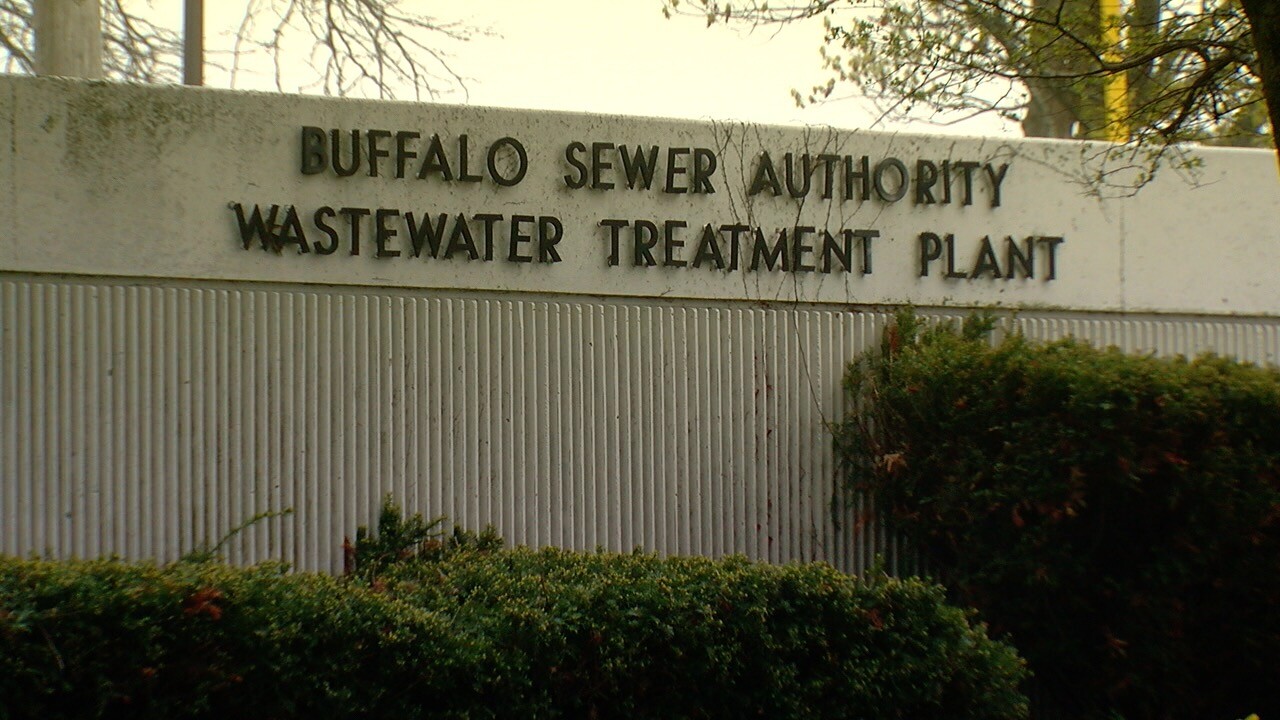BUFFALO, N.Y. (WKBW) — To Margaux Valenti, the 1970s were the “bad old days” on Buffalo’s waterfront.
“We had a Buffalo River that was on fire,” said Valenti, legal and program adviser for Buffalo Niagara Waterkeeper. “We had a Lake Erie that was pronounced dead. And we had a failing economy that was in part due to a polluted waterfront.”
That has changed dramatically, with Lake Erie and the Buffalo and Niagara rivers becoming hot spots for those who want to live, work and play downtown.
But all isn’t well on our corner of the Great Lakes.
The 7 Eyewitness News I-Team has obtained federal data showing that multiple companies have violated pollution laws that were enacted decades ago to keep our land and water safe.
The federal government has classified two Buffalo businesses -- the Aurubis Buffalo brass and copper manufacturing plant off Military Road and Harbour Place Marine Sales on Niagara Street -- as “significant” violators of laws enforced by the Environmental Protection Agency, according to hundreds of pages of government records reviewed by the I-Team.
The records revealed violations of two federal laws on pollution: the Resource Conservation and Recovery Act of 1976 and the Clean Water Act of 1977.
“In the ‘70s, we start to get these big environmental laws,” said Valenti. “And what they gave us was knowledge, accountability and enforceability.”
Aurubis Buffalo was largest violator

Aurubis Buffalo, according to its website, “produces copper and brass plate, which is used to manufacture a number of widely used products such as roofing copper and brass hose nozzles.”
It also handles 2,500 pounds of hazardous waste per month, documents stated, and is considered by state regulators to be a “large quantity generator,” which means it is subject to additional regulations.
A DEC inspector visiting the factory in May 2016 found multiple violations relating to the improper storage of hazardous waste. The inspector stated in DEC documents that workers did not properly label a 250-gallon tote of Hydrochloric acid as hazardous waste and failed to provide records regarding the proper training of employees to handle hazardous waste.
Factory officials also failed to produce, as required by law, a contingency plan “designed to minimize hazards to human health or the environment from fires, explosions, or any unplanned sudden or non-sudden release of hazardous waste or hazardous waste constituents to air, soil or surface water.”
State regulators required the facility to fix the violations and in June 2018 slapped Aurubis Buffalo with a $35,500 fine.
But just five months later, records show a DEC inspector again found problems with the company’s petroleum bulk storage program, including unreported spills, incorrect labeling of kerosene, a lack of maintenance for spill-prevention equipment and tanks that were not inspected as required by law.
The facility in its November 2018 inspection also lacked overfill prevention measures, corrosion-resistant pipes, check valves and operating valves on some of its tanks, according to violation notices issued by the DEC.
Then came the spills.
The company in April 2018 failed to report the release of 60,000 gallons of sodium hydroxide wastewater, DEC records stated.
Two months later, hazardous waste spilled again -- this time, in the form of dust -- because company officials did not maintain proper fire suppression systems, state officials said.
In December 2019, more hazardous dust was released from the facility’s bag house into the surrounding neighborhood, including an adjacent property, documents stated.
And twice in 2020, more than 100 gallons of sulfuric acid spilled on the factory’s concrete floor, including an estimated 85 gallons that washed into the storm drain, according to state environmental records.
“Anytime that toxic or hazardous waste is discharged into our lakes, there is significant cause for concern,” said Brian Smith, associate executive director for the nonprofit Citizens Campaign for the Environment. “These lakes provide drinking water to millions of residents, they support billion-dollar industries locally, and they’re really just essential for quality of life.”
Because Buffalo has a combined sanitary and stormwater sewer system, if spills happen on rainy days, there’s a greater chance that chemicals could pour into our waterways, Valenti said.
“The contaminants, and the water, and any sanitary waste all go unfiltered, straight discharged into the water without going through the treatment plant,” Valenti said. “So that is one way that contaminants can end up directly in a waterway without any kind of treatment.”
This March, company officials agreed to a settlement with DEC officials that required them to pay $240,399 in fines and make improvements to the facility. But the latest data on the EPA website stated that the company was still considered to be a “Significant Noncomplier” with six sections of the Resource Conservation and Recovery Act.
In a written statement, a spokesperson for the DEC stated that the agency “is committed to holding facilities accountable for violating state environmental laws and regulations” and that its latest enforcement actions “are part of DEC’s active and ongoing efforts to monitor operations at these facilities and enforce compliance with all applicable permits, laws, and regulations to protect public health and the environment.”
Aurubis Buffalo officials declined an interview request but in a written statement, company president Dustin R. Snyder said, “We take our environmental, health, and safety responsibilities very seriously at Aurubis. Our work with the DEC reflects our commitment to compliance and continuous improvement in environmental performance. We have come to agreement on our environmental upgrade projects. Work is already underway to complete them. We appreciate the DEC’s efforts in working cooperatively with us to achieve this outcome.”
Harbour Place Marine Sales

The other place in Buffalo identified by the EPA on its website as being in “significant” noncompliance was Harbour Place Marine Sales, Inc., a marina and boat shop on Niagara Street adjacent to AcQua restaurant and event center.
In April 2015, officials at Harbour Place Marine Sales received a letter from the DEC stating that the company failed to submit Discharge Monitoring Reports for the 2014 calendar year. The company, as part of its stormwater discharge permit, is required to submit the reports by Feb. 28 of each year.
“The only issue we’ve had from them is a late filing fee,” Harbour Place president Gary Hall said when reached by phone, referring to regulators.
One day after receiving the letter, officials hired by the company provided the DEC with its discharge report but soon received bad news from state regulators: it was discharging too much iron and aluminum into state waters, documents stated. The company was required to test again and submit follow-up samples to the department.
“I’ll be honest with you,” Hall said. “I don’t have a clue what you’re talking about there. We pay dearly for an environmental film to do our testing and fill out all the required forms with DEC annually, because the average human being cannot understand their forms, their terminology.”
Valenti, of Buffalo Niagara Waterkeeper, said the discharge reports play an important role in ensuring transparency about what is in our water.
“The discharge reports correlate to the company's permit, and it enables the public to look up exactly how much of what contaminants, in what neighborhood, and what effects it's having,” Valenti said. “Without those permits, without those reports, nobody would really have any way to know but for the company itself.”
But in 2019, the company again failed to submit the discharge reports for the first half of the year to the state, according to a DEC violation notice sent to the company. In February 2020, it reached a settlement with the DEC that required it to pay a $1,140 fine for its failure to submit the reports. Hall said the environmental firm hired by his company reimbursed Harbour Place for the fine because the firm was responsible for the filing error.
But recent data on the EPA website stated that the company still did not submit discharge monitoring reports through the end of 2020 and was considered by regulators to be in “Significant/Category I Noncompliance” of portions of the Clean Water Act.
Asked whether his company was currently in compliance with all state water regulations, Hall said, “Absolutely. We do whatever we have to do to comply.”
Buffalo’s sewer system also pollutes

Environmental laws like the Clean Water Act, as well as state laws enforced by the DEC, have been “largely effective” at stopping the discharge of industrial waste into the Great Lakes, said Smith of Citizens Campaign for the Environment.
“But rather regrettably, there are still bad actors out there that continue to pollute,” he said. “So we have to be diligent and ensure that we're enforcing and holding these companies accountable.
The problem isn’t limited to Buffalo.
The cost of upgrading and maintaining wastewater infrastructure over the next two decades is an estimated $40 billion in New York State alone, Smith estimated.
Much of the funding to this point has been targeted through the Great Lakes Restoration Initiative, which according to its website, provides “funding to 16 federal organizations to strategically target the biggest threats to the Great Lakes ecosystem.”
Those threats include the introduction of PFAS, commonly known as “forever chemicals,” into Great Lakes waterways, as well as microplastics and overflows from combined sewer systems in cities like Buffalo.
Experts point to the Buffalo River as an example of how cleaning a polluted body of water can lead to almost instant economic development and recreational opportunities.
“That has been so successful in removing these legacy contaminants and helping to spur economic growth along our waterfront,” Smith said. “So on one hand we can't be making these major investments in cleaning up the legacy pollution, while continuing to allow industry to continue to pollute. It's one step forward and one step back.”
Citizens who want to look up water quality or environmental data on the EPA’s website can visit https://echo.epa.gov/.



